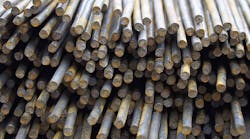The World Steel Association issued a new, semi-annual Short Range Outlook (SRO) for 2022 and 2023, forecasting global steel demand will contract by -2.3% in 2022 – to 1.796 billion metric tons. It then foresees 2023 steel demand rising by 1.0% to reach 1.8 billion metric tons. The downward revision reflects “the repercussion of persistently high inflation and rising interest rates globally,” according to World Steel, which added that “high inflation, monetary tightening, and China’s slowdown” have reshaped the global economic picture for 2022.
World Steel is a trade association with members in 64 countries, who represent about 95% of global steel capacity.
Máximo Vedoya, CEO of Ternium and chairman of the World Steel Economics Committee, said, “The global economy is affected by persisting inflation, U.S. monetary tightening, China’s economic deceleration, and the consequences of Russia’s invasion of Ukraine. High energy prices, rising interest rates, and falling confidence have led to a slowing in steel using sectors’ activities.”
However, World Steel posited that infrastructure investments will lift 2023 steel demand “slightly.”
Steel “demand” – also described as “apparent steel consumption” – typically trails steel production totals, due to the scale of the steel production process, the varieties of steel needed for different market requirements, volume-production contracts for major consumers, like automakers, and various other factors that generally result in production totals surpassing demand totals.
Actual global steel production totaled 1.95 billion metric tons during 2021. The current year-to-date (January-August 2022) total for global steel production is 1.25 billion metric tons – which nominally suggests a total annual production of 1.88 billion metric tons for 2022.
Some of the explanations the World Steel forecasters offer now for downgrading the 2022 demand outlook were already in evidence in their April report, when they pegged 2022 demand to remain even (+0.4%) with the 2021 total. Then, the determining factors they cited were Chinese government restrictions on real-estate and construction growth, with additional effects of rising inflation worldwide and instability surrounding the Russia-Ukraine conflict.
Now, World Steel states that “the global economic environment has deteriorated significantly … as (the) inflation risk fully materialized along with other major headwinds, namely the Russia-Ukraine war and China’s lockdowns.
“The Russia-Ukraine war exacerbated the inflationary pressure that was ignited by the post-lockdown supply and demand imbalances, as the war disrupted energy and food supplies and intervened with the normalization of supply chains. In particular in Europe, where dependence on Russian gas supply is high, economic activities, as well as confidence, are heavily affected by the energy crisis,” World Steel summarized.
Among several points detailing the steel demand outlook, World Steel reports that steel demand in China fell -6.6% during the first eight months of 2022, and is seen falling by -4.0%. For all of 2022, Chinese steel demand is seen falling -4.0%.
For 2023, infrastructure projects and “a mild recovery” in China’s real-estate market could prevent further contraction, and the forecast now calls for Chinese market demand to remain flat. However, World Steel cautioned that “the slowing global economy poses further downside risk for China.”
EU steel demand is seen contracting by -3.5% in 2022, with no immediate improvement in gas supplies, and “significant downside risk” in case of severe winter weather or further disruptions to energy supplies. The region also faces financial risks related to high deficits and slow growth in China – and the regional economic structure (and thus steel demand) may suffer long-term consequences if the economic constraints continue at the current level.
Alternatively, an end to the Russia-Ukraine war soon offers an opportunity for an improved outlook in the region.
World Steel reports that “a sustained and strong recovery of the U.S. economy from the pandemic shock is coming to an end” as the Federal Reserve Bank aggressively imposes interest-rate increases to contain inflation. Manufacturing activity is heading for a sharp reduction thanks to a weak economic environment, strong dollar, and consumers’ shifting spending from goods to services.
“However,” World Steel offers, “the (U.S.) automotive sector is expected to maintain the positive momentum on the back of pent-up demand and easing of supply chain constraints.
“The construction sector will struggle due to the easing of the housing boom,” it continued, “and the delayed recovery of the non-residential sector on the back of rising materials cost and high interest rates.” Federal infrastructure spending will be positive for U.S. steel demand, according to World Steel, as will rising energy-sector investments. The net effect will be that overall U.S. steel demand is not likely to contract.






